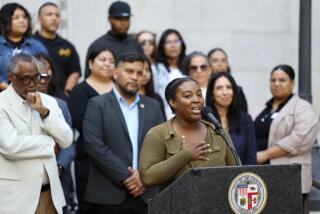Riverside Welfare-to-Work Success Touted : Benefits: County agency’s top priority is finding jobs--any jobs--for aid recipients. And the program operates at a profit.
RIVERSIDE — Lawrence Townsend Jr., Riverside County’s welfare chief, is growing accustomed to the accolades his department is receiving for its success in weaning people off welfare and into jobs.
Add to his boosters Gov. Pete Wilson, who, in calling for welfare reform in his State of the State address Monday, said Riverside County’s welfare program will be the model for counties statewide to emulate.
“In Riverside County,” Wilson said, “we’ve learned that welfare recipients don’t learn about work by watching filmstrips or having round-table discussions about work. . . . Welfare recipients in Riverside County have succeeded by putting work first.”
But Townsend warns that many of his counterparts around the state are resistant to the philosophy that quickly placing welfare recipients into jobs is more important than offering them education and job training with the hope of their attaining better jobs, an underpinning of many welfare programs.
“We’re talking about changing long-entrenched ideology--that training and long-term education will automatically cause welfare recipients to be employed,” Townsend said.
Riverside’s strictly defined mission is first and foremost to find jobs for welfare recipients--even part-time jobs, even low-paying jobs--so they will earn a paycheck, develop a work ethic, build a resume and eventually move into better jobs. Clients are required to attend five morning classes to discuss how to identify their assets, develop resumes, dress for job interviews and the like, and are then ushered to a bank of telephones to start their job searches.
For a time after welfare recipients get jobs, their government benefits are reduced but not eliminated, as an incentive for them to gain employment.
The 100 or so job counselors who work for Townsend are evaluated primarily on their success in helping to find jobs for their clients; if they don’t place 12 people in jobs each month, they may find themselves without a job, Townsend warns them. Since 1987, the county has developed a roster of local employers willing to hire welfare recipients.
As a result, Riverside County’s Department of Public Social Services is a net-profit center: Last year, the county spent $10.5 million to operate the job-finding program--and welfare payments were reduced by more than $18 million.
“We turned a 184% net profit,” Townsend says with a laugh. “I’m trying to find out what it takes for us to become a Fortune 500 company.”
Riverside County was one of nine counties in the state’s welfare-to-work program, called GAIN (Greater Avenues for Independence), to be evaluated over a three-year period for their success in helping welfare recipients, mostly single mothers who receive Aid to Families With Dependent Children.
Researchers described Riverside’s results as “the most impressive . . . ever found for a large-scale welfare-to-work program.” The program “set a new standard of achievement,” Judith M. Gueron, president of the nonprofit Manpower Demonstration Research Corp., wrote in September.
Los Angeles County welfare officials were so impressed with Riverside’s successes that they have adopted much of Riverside’s philosophy.
“Since embracing a work-first approach and establishing a more equal emphasis on employment and education, our job placements have increased more than 200% over last year,” said Pat Knauss, manager of Los Angeles County’s GAIN program.
“Our message now is, ‘A job, a better job, a career,’ ” she said. “We’re telling people now that you learn from working as well as you do in the classroom.
“And we’re finding that a lot of people who still need basic education still want to get a job first. They want to work.”
More to Read
Sign up for Essential California
The most important California stories and recommendations in your inbox every morning.
You may occasionally receive promotional content from the Los Angeles Times.










